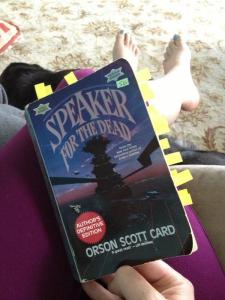Visual Literacy – Which of the Thousand Words Do You Mean?
by rebeccaamytodd
This is how I read fiction for fun
I am a semanticist. I love language and words. I collect them. My fiction books are flagged and highlighted, often to mark exciting phrasings. I know that one of my favourite phases ever crafted in the English language lives in the first paragraph on page 17 of Ondaatje’s In The Skin Of A Lion. I know that I first learned “inchoate spate” from Heinlein, and “Hoist with his own Petard” from Vonnegut.
Tied to my love of language, perhaps, is a desire for precision in communications. I feel a great difference between ‘hate’ and ‘dislike’, for instance. To me, they are not synonymous. And I don’t care what The Googles say, literally and figuratively do NOT mean the same thing.
I’ve written before about the flip side of this struggle – how I find visuals to frequently be murky. Emoticons, for instance, boggle my mind. I wrote about that more extensively over here in my post on Spin Sucks, and I am not going to rehash all of that here and now.
Today, I was in a wonderful webinar presented by Richard Binhammer and hosted by Spin Sucks Pro. Richard’s different presentation style really resonated with me, as did his message. What really grabbed my attention was his discussion around Visual Literacy.
I’m not a neuroscientist (surprise!), but I have a strong fascination with how we create meaning on the neurological level. Our brains store and link disparate pieces of information, which we retrieve almost instantaneously, through the development of physical neurological pathways. We store the image of an apple alongside our memories of the apple- the taste, the crisp sound of the first bite, the time I lost my tooth in a Macintosh at school, the way way spell the word graphophonically, in English and any other languages we speak.
To say, then, that a picture is worth a thousand words could be quite true, or could be a vast underestimation, depending on our personal experience with the subject matter. Exactly what those thousand words are will vary from person to person.
To stick with apple, perhaps I like them and perhaps you don’t. Showing us each the same image of a lovely ripe Honey Crisp will resonate differently with each of us, then. The way my mind has already made it a ‘Honey Crisp’, my favourite sort of apple, is proof of this. The way my brain has also been shouting “Pomme de rue!!!” and then began singing me “Long Time Running” is further evidence of how vast and varied the potential neural pathways, all from a simple word: Apple.
So yes- your visual may in fact be worth a thousand words, more or less. But which of those words do you actually mean? Assuming that the thousand words my mind relates to a subject and what yours connects could lead to misunderstandings. Unlike written words which have generally agreed upon definitions easily accessible through dictionaries, images do not.
As I endeavor to use more images to connect to visual learners and support my text, I would also encourage you to consider how to use text to bring clarity to your images. And if you are in need of a non-native speaker of the visual language, I’m here for you. Just don’t expect that I will understand you if you speak in hieroglyphics.

